THE KENYA NATIONAL EXAMINATIONS COUNCIL
K.C.P.E 2015
Science
Time: .1 hour 40 minutes
Read these instructions carefully
1. You have been given this question booklet and a separate answer sheet. The question booklet contains 50 questions.
2. Do any necessary rough work in this booklet.
3. When you have chosen your answer, mark it on the ANSWER SHEET, not in this question booklet.
How to use the answer sheet
4. Use an ordinary pencil.
5. Make sure you have written on the answer sheet:
Your index number
Your name
Name of your school
6. By drawing a dark line inside the correct numbered boxes, mark your full Index Number (i.e. School Code Number and the three—figure Candidate’s Number) in the grid near the top of the answer sheet.
7. Do not make any marks outside the boxes.
8. Keep the sheet gs clean as possible and do not fold it.
9. For each of the questions 1-50,four answers are given. The answers are lettered A, B, C and D. In each case only 10. ONE of the four answers is correct.,Choose.the correct answer.
On the answer sheet the correct answer is to be shown by drawing a dark line inside the box in which the letter you have chosen is Written.
Example:
In the Question Booklet:
4. Some curative drugs are also called
A. painkillers
B. vaccines
C. stimulants
D. antibiotics
The correct answer is “D”
On the answer sheet:
4.[A] [B] [C] [D] 14.[A] [B] [C] [D] 24.[A] [B] [C] [D] 34.[A] [B] [C] [D] 44. [A] [B] [C] [D] In the set of boxes numbered 4, the box with the letter D printed in it is marked.
11. Your dark line MUST be within the box.
12.For each question ONLY ONE box is to be marked in each set of four boxes.
This question paper consists of 7 printed pages.
1. The main function of the hair and mucus found in the breathing system is to
A. help in exchange of gases
B. clean the air
C. protect the nose
D. keep the trachea open.
2. The following are characteristics of a certain type of tooth:
(i) sham
(ii) chisel shaped
(iii) has one root
The type of tooth described is a
A. molar
B. canine
C. premolar
D. incisor.
3. Which one of the following pairs of diseases is correctly matched with the time of immunization?
Six weeks Nine months
A. Hepatitis B Yellow fever. B. Measles Tuberculosis. C. Diphtheria Pertussis. D. Polio Tetanus.
4. Which is the last stage in energy transformation when a kerosene stove is burning?
A. Chemical.
B. Heat.
C. Light.
D. Sound.
5. The diagram below represents a set-up that can be used to demonstrate a certain aspect of heat energy.
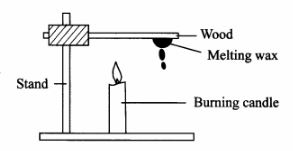
The aspect that can be demonstrated is
A. radiation and convection
B. expansion and conduction
C. convection and conduction
D. expansion and radiation.
6. Which one of the following is a compound fertilizer?
A. Muriate of potash
B. Triple Super Phosphate
C. Sulphate of Ammonia
D. Mono Ammonium phosphate
7. Which one of the following statements is correct about the digestive system? A. Oesophagus makes it easy for food absorption.
B. Stomach mixes food with digestive juices.
C. Digestion of food occurs in the large intestine.
D. Water is absorbed in the small intestine.
8.The picture below represents a type of interdependence between plants.
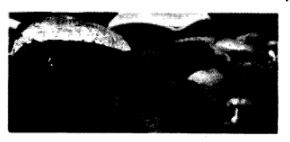
The type of interdependence represented is
A. support
B. shade
C. habitat
D. shelter.
9. A pupil used water that had been used in rinsing clothes to mop the floor. Which method of water conservation did the pupil practice?
A. Re-using water.
B. Using water sparingly.
C. Recycling water.
D. Water harvesting.
10. The importance of fibre in the human diet is to help in the
A. digestion of food
B. movement of food
C. absorption of water
D. absorption of nutrients.
11. The following are characteristics of a certain animal:
(i) lays eggs
(ii) has constant temperature
(iii) has a hairy body
The animal is likely to be
A. ostrich
B. spiny anteater
C. whale
D. bat.
12. The picture below shows a tomato plant with a sign of crop disease.
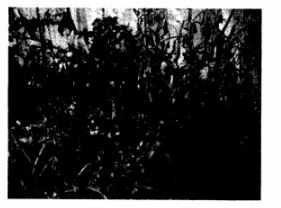
The sign shown is
A. leaf curling
B. spots
C. streaks
D. wilting.
13. Which one of the following components of air is correctly matched to its percentage?
Oxygen Inert gases
A. 21 78
B. 0.97 0.03
C. 21 0.97
D. 0.03 78
14. Which one of the following is a social effect of drug abuse?
A. Truancy.
B. Fits.
C. Withdrawal.
D. Addiction.
15. The chart below represents a simple classification of plants.
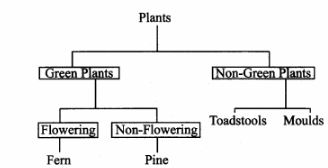
Which one of the following plants is not correctly classified?
A. Moulds.
B. Pine.
C. Toadstool.
D. Fern.
16. A child has the following signs and symptoms:
(i) gets out of breath
(ii) pale skin
(iii) dizziness.
Which one of the following foods should the child feed on?
A. Yams and cassava.
B. Beans and maize.
C. Kidney and spinach.
D. Carrots and pineapples.
17. Which one of the following materials is non magnetic?
A. Copper wire.
B. Steel wool.
C. Office pin.
D. Razorblade.
18. Which one of the following statements is correct about proper use and storage of medicine?
A. Sharing medicine with family members.
B. Labelling medicine containers.
C. Keeping medicine in a well lit place.
D. Storing medicine in sealed water bottles.
19. Anaemia and irritation in livestock can be a sign of attack by
A. liver flukes
B. tapeworms
C. tsetse flies
D. round worms.
20. Which of the following body fluids is the least likely to transmit HIV?
A. Breast milk.
B. Semen.
C. Vaginal secretions.
D. Saliva.
21. The picture below shows parts of a flower.
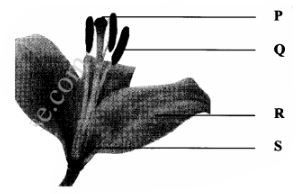
The parts labeled P, Q, R and S are
P Q R S
A. Anther Stigma Sepal Ovary
B. Style Filament Petal Ovule
C. Stigma Anther Petal Ovary
D. Filament Style Sepal Ovule
22. Which one of the following physical changes observed in boys and girls during adolescence is not correctly matched?
Boys Girls
A. Voice breaks Pubic hair grows
B. Wet dreams Hips broaden
C. Pimples on face Chest broadens
D. Pubic hair grows Pimples on face
23. Which one of the following livestock parasite control measures can be applied for both ticks and tapeworms?
A. Rotational grazing.
B. Dipping.
C. Deworming.
D. Spraying.
24. Which one of the following methods will mainly conserve soil and not water? A. Mulching.
B. Terracing.
C. Cover crops.
D. Gabions.
25. In a certain activity, a sample of soil was mixed with water in a transparent container, shaken and allowed to settle.
This was to investigate soil
A. drainage
B. fertility
C. composition
D. capillarity.
26. The most effective control measure against HTV transmission from mother to child is
A. public awareness on HIV/AIDS
B. voluntary counselling and testing
C. mass education
D. campaign through various media.
27. The surrounding of an organism is described as its
A. environment
B. home
C. shelter
D. habitat.
28. The diagram below shows parts of the human heart.
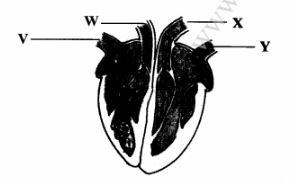
Blood from the legs enters the heart through the blood vessel labelled
A. V
B. W
C. X
D. Y
29. Which one of the following is the most commonly abused drug in Kenya?
A. Khat.
B. Glue.
C. Tobacco.
D. Alcohol.
30. The following materials can be used to construct a certain weather instrument:
(i) small plastic bottle
(ii) large plastic bottle
(iii) manila paper
(iv) cello tape.
The weather instrument likely to be constructed is
A. air thermometer
B. wind vane
C. rain gauge
D. liquid thermometer.
31. Which one of the following uses of Water is not practised on the farm?
A. Mixing chemicals.
B. Washing toilet.
C. Cleaning implements.
D. Irrigation.
32. An example of a lever in which the load is between the effort and fulcrum is
A. wheelbarrow
B. spade
C. claw hammer
D. crowbar.
33. Which one of the following statements describes hard water?
A. Contains less mineral salts.
B. Lathers easily.
C. Boiled water.
D. Discolours clothes.
34. The following are some characteristics of plants:
(i) thin cuticle
(ii) silvery hairs
(iii) flexible stems
(iv) more stomata on lower leaf surface
(v) air sacs
Which pair of characteristics is for plants adapted to wet areas?
A. (ii) and (iv)
B. (i) and (v)
C. (iii) and (iv)
D. (i) and (ii)
35. Which one of the following is an example of a harmful animal?
A. Turkey.
B. Donkey.
C. Termite.
D. Dog.
36. The following are misconceptions about HIV and AIDS EXCEPT
A. HIV and AIDS is a curse
B. sex with a young girl cures HIV and AIDS
C. HIV and AIDS has no cure
D. all thin people have AIDS.
37. Which one of the following is the least effective preventive measure against the spread of typhoid?
A. Washing vegetables and fruit.
B. Washing hands alter visiting a toilet.
C. Proper use of latrines and toilets.
D. Draining stagnant water.
38. During a thunderstorm, pupils were observed
(i) sheltering under the verandah
(ii) wearing red jackets in a classroom
(iii) playing on the football pitch
(iv) lying on the ground in the classroom
In which pair of observations are the pupils more likely to be struck by lightning?
A. (i) and (iii)
B. (i) and (iv)
C. (ii) and (iii)
D. (ii) and (iv)
39. In which one of the following activities is renewable energy in use?
A. Driving a petrol powered car.
B. Using a windmill to grind maize.
C. Cooking on energy saving charcoal stove.
D. Using coal to generate electricity.
40. Which one of the following mixtures can be separated by either picking or sieving?
A. Maize and beans.
B. Rice and sorghum.
C. Maize and millet.
D. Green grams and peas.
41. Which one of the following is a way of maintaining simple tools?
A. Cleaning before use.
B. Storing in a safe place.
C. Using a tool for several purposes.
D. Oiling.
42. The following are some of the materials that were provided to pupils for making a beam balance:
(i) two tins of the same size
(ii) wires
(iii) plank of wood
(iv) nails
Which one of the following materials was missing?
A. Stand.
B. Strings.
C. Scale.
D. Pins.
43. Which one of the following is an effect of air pollution on non-living things?
A. Impairs visibility.
B. Damages iron sheets.
C. Causes wilting.
D. Interferes with photosynthesis.
44. To model the solar system, the following materials can be used:
(i) soft board
(ii) clay
(iii) pins
(iv) glue
(v) manila paper.
Which one of the following materials would be most suitable to use instead of the pins?
A. Wax.
B. Plasticine.
C. Pieces of barbed wire.
D. Pieces of cello tape.
45. Which one of the following statements is true about splash erosion?
A. Forms shallow trenches.
B. Caused by wind and water.
C. Removes a thin layer of soil.
D. Occurs below roofs of buildings.
46. Which one of the following practices is the most effective in prevention of food poisoning from packed foods?
A. Washing hands before handling it.
B. Checking the expiry date.
C. Proper storage.
D. Proper cooking.
47. The diagram below shows a set-qr used to demonstrate a certain aspect of matter.
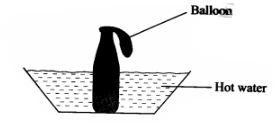
Which one of the following is likely to occur after some time?
A. Air gets into the balloon.
B. Heat enters the balloon.
C. Water enters into the bottle.
D. Balloon contracts.
48. The following statements are true about energy except
A. it causes motion
B. it can be conserved
C. it changes from one form to another
D. is the ability to do work.
49. Which one of the following pairs of materials is suitable for demonstrating the formation of a rainbow when using the sun as a source of light?
A. Ruler and mirror.
B. Mirror and water.
C. Mirror and white screen.
D. Glass container and minor.
50. Which one of the following materials will not form a shadow when light is shone on it?
A. White paper.
B. Mirror.
C. Glass of a lamp.
D. Sheet of aluminium.
2015 KCPE Science Past Paper-Marking Scheme/Answers
1 B
2 D
3 A
4 C
5 A
6 D
7 B
8 C
9 A
10 B
11 B
12 D
13 C
14 A
15 D
16 C
17 A
18 B
19 C
20 D
21 C
22 C
23 A
24 D
25 C
26 B
27 A
28 A
29 D
30 C
31 B
32 A
33 D
34 B
35 C
36 C
37 A
38 A
39 B
40 C
41 D
42 A
43 B
44 C
45 D
46 B
47 A
48 A
49 B
50 C

